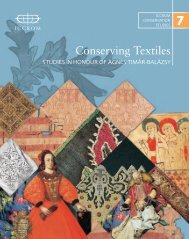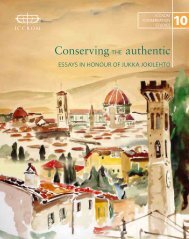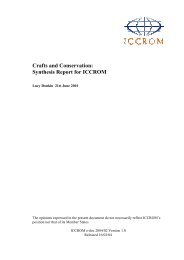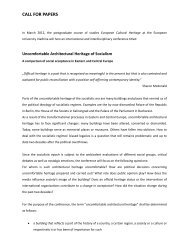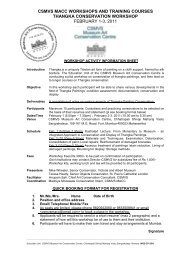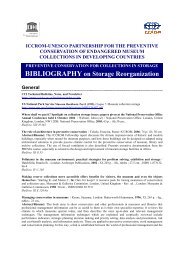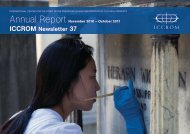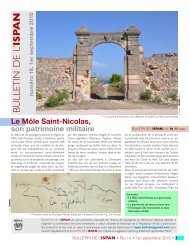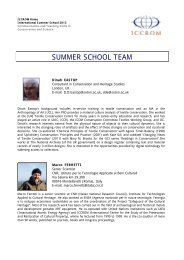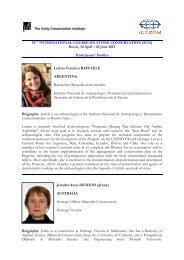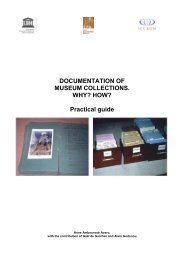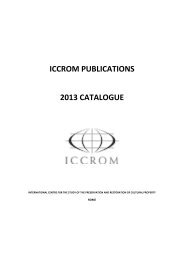Download - Iccrom
Download - Iccrom
Download - Iccrom
Create successful ePaper yourself
Turn your PDF publications into a flip-book with our unique Google optimized e-Paper software.
First Aid to Cultural Heritage in Times of Conflict 2011<br />
Rome, 26 September – 28 October<br />
COURSE BIBLIOGRAPHY<br />
WEEK 1 2<br />
Setting the Scene and Understanding the Context 2<br />
WEEK 2 3<br />
Institutional Response to Conflict: National and International 3<br />
The Law 3<br />
European Union Legislation 3<br />
International Conventions 3<br />
International Agreements and Declarations 4<br />
Commentary 4<br />
Civil-Military Cooperation & Ethics 9<br />
Negotiation 11<br />
WEEK 3 12<br />
Tools, Planning and Salvaging 12<br />
Websites 14<br />
Cultural Heritage, Conflict/Disaster 14<br />
Plundering, Looting, Smuggling 14<br />
WEEK 4 15<br />
Management of Teams, Communication Skills and Security 15<br />
WEEK 5 16<br />
Early recovery: monitoring and evaluation 16<br />
Some Examples Regional Focus 17<br />
Middle-East 17<br />
Afghanistan 18<br />
Field Trips 19<br />
Church of San Giorgio al Velabro 19<br />
L’Aquila 19<br />
Useful links 20
First Aid to Cultural Heritage in Times of ConfIict 2011<br />
BIBLIOGRAPHY<br />
WEEK 1<br />
Setting the Scene and Understanding the Context<br />
Bouchenaki, B. 2003. Setting up the International Collaboration Framework . Museum<br />
International. Volume 55, Issue 3-4, December 2003, 126–138.<br />
Canadian Conservation Institute. The Agents of Deterioration<br />
http://www.cci-icc.gc.ca/crc/articles/mcpm/index-eng.aspx<br />
Canadian Conservation Institute. CCI Notes<br />
http://www.cci-icc.gc.ca/crc/notes/index-eng.aspx<br />
Catherine S. Emergency Preparedness and Salvage in the Event of Armed Conflict.<br />
MUSEUM SOS.<br />
http://museum-sos.org/docs/strat_emergency_preparedness.pdf<br />
Hilhorst, D. & Jansen, B., 2005. Fieldwork in Hazardous Areas. Disaster Studies,<br />
Wageningen University.<br />
http://www.disasterstudies.wur.nl/NR/rdonlyres/23657A36-F37E-424E-8869-<br />
3E89380588F7/34608/Fieldmanualcompressed.pdf<br />
ICCROM. 2005. Cultural Heritage in Postwar Recovery. Papers from the ICCROM Forum<br />
held on October 4-6, 2005. Edited by Stanley Price. ICCROM: Rome, Italy<br />
ICCROM XXVI bis 276<br />
Pdf. Publication available in memory key<br />
Jonathan R.L., 2000. Conservation and Preservation Activities in Archives and Libraries in<br />
Developing Countries. Association of Commonwealth Archivists and Records Managers &<br />
London Metropolitan Archives<br />
http://www.acarm.org/documents/Guidelines%20on%20Preservation.pdf<br />
National Park Service, 1999. Museum Handbook, Part I Chapter 4.<br />
http://www.nps.gov/museum/publications/MHI/CHAPTER4.pdf<br />
Norman, K., 1997. War and the Conservator. 5. The Invasion of Kuwait, and the<br />
Subsequent Recovery of its National Museum: A Conservator’s View. Museum<br />
Management and Curatorship 16/2, 180-191.<br />
ICCROM Per. Grande-Bretagne 46<br />
Roberts, B., 1997. War and the Conservator. 2. War Emergencies: Coordination<br />
and Preparedness Do Pay Off – An International Perspective. Museum Management and<br />
Curatorship 16/2, 160-163.<br />
ICCROM Per. Grande-Bretagne 46<br />
Skaf, I., 1997. War and the Conservator. 4. Recovery Operations at the National<br />
Museum of Beirut. Museum Management and Curatorship 16/2, 173-179.<br />
ICCROM Per. Grande-Bretagne 46<br />
Stanley Price, N., 1997. War and the Conservator. 1. Preventive Measures and<br />
Recovery. Museum Management and Curatorship 16/2, 155-159.<br />
ICCROM Per. Grande-Bretagne 46<br />
2
First Aid to Cultural Heritage in Times of ConfIict 2011<br />
BIBLIOGRAPHY<br />
WEEK 2<br />
Institutional Response to Conflict: National and International<br />
The Law<br />
European Union Legislation<br />
Council Regulation (EC) No 116/2009 of 18 December 2008 on the export of cultural goods,<br />
http://eur-lex.europa.eu/LexUriServ/LexUriServ.do?uri=OJ:L:2009:039:0001:0007:EN:PDF<br />
Council Regulation (EC) No 1210/2003 of 7 July 2003 concerning certain specific<br />
restrictions on economic and financial relations with Iraq.<br />
http://eur-lex.europa.eu/LexUriServ/LexUriServ.do?uri=OJ:L:2003:169:0006:0023:EN:PDF<br />
Council Directive 93/7/EEC of 15 March 1993 on the return of cultural objects unlawfully<br />
removed from the territory of a Member State.<br />
http://eur-lex.europa.eu/LexUriServ/LexUriServ.do?uri=OJ:L:1993:074:0074:0079:EN:PDF<br />
International Conventions<br />
1954 Hague Convention for the Protection of Cultural Property in the Event of Armed<br />
Conflict.<br />
http://www.icomos.org/hague/<br />
1954 First protocol of The Hague Convention for the Protection of Cultural Property in the<br />
Event of Armed Conflict.<br />
http://portal.unesco.org/en/ev.php-<br />
URL_ID=15391&URL_DO=DO_TOPIC&URL_SECTION=201.html<br />
1999 II Protocol to the Hague Convention for the Protection of Cultural Property in the<br />
Event of Armed Conflict.<br />
http://www.icrc.org/ihl.nsf/FULL/590?OpenDocument<br />
1970 UNESCO Convention on the Means of Prohibiting and Preventing the Illicit Import,<br />
Export and Transfer of Ownership of Cultural Property. IN UNITED NATIONS<br />
EDUCATIONAL, S. A. C. O. (Ed.). Paris.<br />
http://unesdoc.unesco.org/images/0011/001140/114046e.pdf#page=130<br />
1972 UNESCO Convention concerning the Protection of the World Cultural and Natural<br />
Heritage.<br />
1995 UNIDROIT Convention on Stolen or Illegally Exported Cultural Objects<br />
http://www.unidroit.org/english/conventions/1995culturalproperty/1995culturalproperty-e.pdf<br />
3
First Aid to Cultural Heritage in Times of ConfIict 2011<br />
BIBLIOGRAPHY<br />
International Agreements and Declarations<br />
1935 Roerich Pact: Potection of Artistic and Scientific Institutions and Historic Monuments<br />
http://www.roerich.org/nr_RPact.html<br />
1964 International Charter for the Conservation and Restoration of Monuments and Sites<br />
(Venice Charter)<br />
http://www.international.icomos.org/charters/venice_e.pdf<br />
1992 Code of Conduct for International Red Cross and Red Crescent Movement and NGOs<br />
in Disaster Relief<br />
http://www.ifrc.org/Docs/idrl/I259EN.pdf<br />
1994 The Nara Document on Authenticity<br />
http://whc.unesco.org/uploads/events/documents/event-443-1.pdf<br />
1995 Dayton Agreement Annex 8. Agreement on Commission to Preserve National Monuments<br />
http://www.usip.org/files/file/resources/collections/peace_agreements/dayton_annex8.pdf<br />
2001 Proceedings of the Doha Conference of ‘Ulamâ on Islam and Cultural Heritage<br />
Doha, Qatar.<br />
http://unesdoc.unesco.org/images/0014/001408/140834m.pdf<br />
2003 UNESCO Declaration concerning the Intentional Destruction of Cultural Heritage<br />
http://portal.unesco.org/en/ev.php-<br />
URL_ID=17718&URL_DO=DO_TOPIC&URL_SECTION=201.html<br />
2003 The Hoi An Declarationon Conservation of Historic Districts of Asia<br />
http://www.international.icomos.org/xian2005/hoi-an-declaration.pdf<br />
Commentary<br />
Bos, A., 2005. The Importance of the 1899, 1907 and 1999 Hague Conferences for the Legal<br />
Protection of Cultural Property in the Event of Armed Conflict, Museum International 57, 32-<br />
40.<br />
Boylan, P. J., 1993. Review of the Convention for the Protection of Cultural Property in the<br />
Event of Armed Conflict (the Hague Convention of 1954). UNESCO.<br />
http://unesdoc.unesco.org/images/0010/001001/100159eo.pdf<br />
Boylan, P. J., 2002. The 1954 Hague Convention on the protection of cultural property in<br />
the event of armed conflict and its 1954 and 1999 protocols. IFLA.<br />
http://archive.ifla.org/IV/ifla68/papers/091-099e.pdf<br />
Boylan, P. J., 2006. Implementing the 1954 Hague Convention and its Protocols: legal and<br />
practical implications. Chicago<br />
http://culturalpolicy.uchicago.edu/protectingculturalheritage/papers/Boylan.paper.pdf<br />
Bugnion, F., 2004. La genèse de la protection juridique des biens culturels en cas de<br />
conflit armé, Revue Internationale de la Croix-Rouge 86, No. 854, 313 - 324.<br />
Carducci, G., 1997. La restitution internationale des biens culturels et des objets d’art –<br />
Droit commun, directive CEE, Conventions de l’UNESCO et d’UNIDROIT, Paris.<br />
4
First Aid to Cultural Heritage in Times of ConfIict 2011<br />
BIBLIOGRAPHY<br />
Carducci, G., 2000a. L’obligation de restitution des biens culturels et des objets d’art en<br />
cas de conflit armé : droit coutumier et droit conventionnel avant et après la Convention<br />
de La Haye de 1954. L’importance du facteur temporel dans les rapports entre les traités et<br />
la coutume», Revue générale de droit international public 2, 289 – 357.<br />
Carducci, G., 2000b. Beni culturali in diritto internazionale pubblico e privato, Enciclopedia<br />
giuridica italiana G. Treccani, Rome.<br />
Carducci, G., 2005. Ethics and Heritage: Ethics, Law and Heritage. ICOM News, 58, 5.<br />
http://www.museum.or.jp/icom/pdf/E_news2005/p5_2005-3.pdf<br />
Carducci, G., 2008. The implementation of International Treaties at the national level», in: L.<br />
Rothfield (ed.), Antiquities under siege: Cultural Heritage Protection after the Iraq War,<br />
Lanham – New-York – Toronto – Plymouth, 89 – 100.<br />
ICCROM XXVI bis 297 (1).<br />
Cuno, J., 2006. Beyond Bamiyan: Will the World be Ready Next Time? In: B.T. Hoffman (ed.),<br />
Art and Cultural Heritage. Law, Policy and Practice, Cambridge, 41-46.<br />
ICCROM XXIX B 225<br />
Curtis, J., 2011. Archaeology and Cultural Heritage in War Zones, in: History for the Taking?<br />
Perspectives on Material Heritage, British Academy Report, p. 55-75.<br />
http://www.britac.ac.uk/templates/asset-relay.cfm?frmAssetFileID=10422<br />
Francioni, F., 1988. Controlling illicit trade in art objects: the 1995 UNIDROIT Convention.<br />
In Francioni, F., Del Vecchio, A. & De Caterini, P. (Eds.) Protezione internazionale del<br />
patrimonio culturale: interessi nazionali e difesa del patrimonio comune della cultura.<br />
Roma, Giuffré.<br />
Francioni, F., 2004. Beyond State Soveregnty: The Protection of Cultural Heritage as a<br />
Shared Interest of Humanity. Michigan Journal of International Law, 25, 1209-1228.<br />
http://students.law.umich.edu/mjil/uploads/articles/v25n4-francioni.pdf<br />
Forrest, C., 2010. International Law and the Protection of Cultural Heritage. London – New<br />
York. (especially chapter 3: Cultural heritage and armed conflicts)<br />
ICCROM XXIX B 232<br />
The world's cultural heritage is under threat from war, illicit trafficking, social and economic<br />
upheaval, unregulated excavation and neglect. Over a period of almost fifty years, the United<br />
Nations Educational, Scientific and Cultural Organisation has adopted five international<br />
conventions that attempt to protect this cultural heritage. This book comprehensively and critically<br />
considers these five UNESCO cultural heritage conventions. The book looks at the conventions in<br />
the context of recent events that have exposed the dangers faced by cultural heritage, including<br />
the destruction of cultural heritage sites in Iraq and the looting of the Baghdad museum, the<br />
destruction the Buddhas of Bamiyan in Afghanistan, the salvage of artefacts from the RMS<br />
Titanic and the illicit excavation and trade in Chinese, Peruvian and Italian archaeological objects.<br />
Gerstenblith, P., 2008. The 1954 Hague Convention on the Protection of Cultural Property<br />
in the Event of Armed Conflict (its background and prospects for ratification in the United<br />
States), in: L. Rothfield (ed.), Antiquities under Siege: cultural heritage protection after the Iraq<br />
War, New York – Toronto – Plymouth, 79-88.<br />
ICCROM XXVI bis 297 (1).<br />
Gerstenblith, P., 2010. The Obligations Contained in International Treaties of Armed<br />
Forces to Protect Cultural Heritage in Times of Armed Conflict, IN L. Rush (ed.),<br />
Archaeology, Cultural Property, and the Military, Woodbridge.<br />
ICCROM XXVI bis 334 (1).<br />
5
First Aid to Cultural Heritage in Times of ConfIict 2011<br />
BIBLIOGRAPHY<br />
Harding, A., 2011. The problem of illicit antiquities. An ethical dilemma for scholars, IN:<br />
History for the Taking? Perspectives on Material Heritage, British Academy Report, 77-109.<br />
http://www.britac.ac.uk/templates/asset-relay.cfm?frmAssetFileID=10422<br />
Hensel, H.M., 2005. The Protection of Cultural Objects during Armed Conflict, IN: Howard M.<br />
Hensel (ed.): The Law of Armed Conflict: Constraints on the Contemporary Use of Military Force.<br />
Ashgate, Aldershot/Burlington, 39–104.<br />
Hershkovitch, C., Rykner, D., 2011. La restitution des oeuvres d’art. Solutions et impasses,<br />
Paris.<br />
Hinek, S., 2006. The Judgment of the International Criminal Tribunal for the Former<br />
Yugoslavia in Prosecutor v. Pavle Strugar. Leiden Journal of International Law, 19, 477.<br />
Hladik, J., 2003. The Second Protocol to the 1954 Hague Convention and Progress in<br />
International Humanitarian Law, Museum International 55, 44-50.<br />
Hladik, J., 2003. Risk-Preparedness Under the 1954 Hague Convention for the Protection of<br />
Cultural Property in the Event of Armed Conflict and its Second Protocol. International<br />
Symposium: Cultural Heritage Disaster Preparedness and Response. Hyderabad, India, ICOM.<br />
Hladik, J., 2008. The Main Activities of the UNESCO Secretariat Related to the<br />
Implementation of the Second Protocol to the Hague Convention of 1954, IN Meerts, P. (ed.),<br />
Culture and International Law, The Hague, 155-166.<br />
Kono, T. (ed.), 2011. The Impact of Uniform Laws on the Protection of Cultural Heritage<br />
and the Preservation of Cultural Heritage in the 21 st Century, Leiden – Boston.<br />
Providing an overview of the seven Conventions with the two Protocols adopted by UNESCO and<br />
UNIDROIT, this book offers comparative analysis of legal schemes for the protection or<br />
safeguarding of cultural heritage in 15 countries. This is the publication of the reports presented<br />
at the First Intersessional Thematic Congress of the International Academy of Comparative Law<br />
in November 2008.<br />
ICCROM XXIX B 242<br />
Manacorda, S. and Chappell, D., 2011. Crime in the Art and Antiquities World: Illegal<br />
Trafficking in Cultural Property,<br />
The theft, trafficking, and falsification of cultural property and cultural heritage objects are crimes<br />
of a particularly complex nature, which often have international ramifications and significant<br />
economic consequences. Organized criminal groups of various types and origins are involved in<br />
these illegal acts. The book Crime in the Art and Antiquities World has contributions both from<br />
researchers specializing in the illegal trafficking of art, and representatives of international<br />
institutions involved with prevention and detection of cultural property-related crimes, such as<br />
Interpol and UNESCO. This innovative volume also includes an Appendix of the existing legal<br />
texts, i.e. international treaties, conventions, and resolutions, which have not previously been<br />
available in a single volume.<br />
Maniscalco, F. (ed.), 2002, Protection of Cultural Heritage in war areas, Mediterraneum, vol II,<br />
Naples.<br />
ICCROM VIII A 432/2 (1).<br />
Maniscalco, F., 2007. World Heritage and War, Mediterraneum, vol. VI, Naples.<br />
ICCROM XXVI bis 301 (1)<br />
Matyk, S., 2000. The restitution of cultural objects and the question of giving direct effect<br />
to the Protocol to the Hague Convention for the Protection of Cultural Property in the<br />
Event of Armed Conflict 1954, International Journal of Cultural Property 9, 341-346.<br />
6
First Aid to Cultural Heritage in Times of ConfIict 2011<br />
BIBLIOGRAPHY<br />
Nafziger, J. and Scovarizzi, T. (eds.), 2008. Le patrimoine culturel de l’humanité / The<br />
Cultural Heritage of Mankind, Leiden – Boston.<br />
It is evident that the need to protect cultural objects exceeds the interest of a single owner or a<br />
bona fide purchaser, the State of an object's origin or the State where an object is located.<br />
Despite the complexity of weighing the contending interests and selecting appropriate rules from<br />
a welter of norms and customs, why can't we envisage a truly comprehensive set of international<br />
principles, practices and procedures, to protect the cultural heritage of mankind? Toward this end,<br />
the Centre for Studies and Research of The Hague Academy of International Law's programme<br />
provided a unique opportunity for organized exploration and analysis.This volume presents the<br />
resulting studies prepared by the Directors of Research, together with the more specific reports<br />
by the researchers working within the Centre. Together they offer an inciteful analysis of the<br />
importance of fashioning durable rules and institutions for protecting the cultural heritage of<br />
mankind from the risks of armed conflict or illegal trafficking.<br />
O’Keefe, P., and Prott. L., 2011. Cultural Heritage Conventions and Other Instruments. A<br />
Compendium with Commentaries, Institute of Art and Law.<br />
ICCROM XXIX B 241<br />
This book, with commentaries from two of the leading experts in the law of cultural heritage,<br />
provides all the significant texts of international law on the protection of heritage and includes a<br />
short commentary on the evolution of each one and on their relationship to one another. The<br />
instruments discussed include the most significant UNESCO Conventions, including that of 1970<br />
on Illicit Trade, 2001 on Underwater Cultural Heritage, 2003 on Intangible Cultural Heritage, the<br />
Unidroit 1995 Convention, the Hague Convention 1954 and its two Protocols, the Convention for<br />
the Protection of the Architectural Heritage of Europe 1985, European Convention on the<br />
Protection of the Archaeological Heritage (Revised) 1992, the European Landscape Convention<br />
2000, the Council of Europe Framework Convention on the Value of Cultural Heritage for Society<br />
2005, together with a wide range of recommendations and declarations from UNESCO, the<br />
Council of Europe and the United Nations. Colour illustrations throughout the book demonstrate<br />
the immense diversity of heritage that is legally protected today. This book is a fundamental<br />
working tool for all cultural professionals and academics, including anthropologists,<br />
archaeologists, architects, cultural administrators, legal advisers, museum staff and site curators.<br />
Petzet, M. and Perot, J., 2003. The Role of Non-governmental Organizations in<br />
International Emergency Action. Museum International. Volume 55, Issue 3-4, December 2003,<br />
119–125.<br />
Prott, L., 1988. Commentary: 1954 Hague Convention for the protection of Cultural<br />
Property in the Event of Armed Conflict, in: N. Ronzitti, The law of naval warfare, Dordrecht,<br />
583f.<br />
Prott, L., 1993. The Protocol of the Convention for the Protection of Cultural Property in<br />
the Event of Armed Conflict (The Hague Convention) 1954, in: Humanitäres Völkerrecht –<br />
Informationsschriften, Bonn, vol 4, 191-194.<br />
Prott, L., 2009. Ten years in force – the UNIDROIT Convention on Stolen or Illegally<br />
Exported Cultural Objects, Art Antiquity and Law 14, 195-218.<br />
ICCROM Per. International 50<br />
Prott, L., 2009. Witnesses to History. Documents and Writings on the Return of Cultural<br />
Objects, UNESCO Publishing Paris.<br />
ICCROM XXIX B 229<br />
Prott, L., 2011. Strengths and Weaknesses of the 1970 Convention: An Evaluation 40 years<br />
after its adoption<br />
http://unesdoc.unesco.org/images/0019/001918/191880E.pdf<br />
7
First Aid to Cultural Heritage in Times of ConfIict 2011<br />
BIBLIOGRAPHY<br />
Schindler, D., Toman, J. (eds.), 1988. The laws of armed conflicts: a collection of<br />
conventions, resolutions, and other documents. 3 rd ed., Alphen aan den Rijn.<br />
Stamatoudi, I., 2011. Cultural Property Law and Restitution, Cheltenham.<br />
This book brings together the international and European Union legal framework on cultural<br />
property law and the restitution of cultural property. Theories of cultural nationalism and cultural<br />
internationalism and their founding principles are explored. Irini Stamatoudi also draws on soft<br />
law sources, ethics, morality, public feeling and the role of international organisations to create a<br />
complete picture of the principles and trends emerging today.<br />
Toman, J., 1996. The Protection of Cultural Property in the Event of Armed Conflict:<br />
Commentary on the Convention for the Protection of Cultural Property in the Event of<br />
Armed Conflict and its Protocol, Signed on May 14 1954 in The Hague and Other<br />
Instruments of International Law Concerning Such Protection, Aldershot.<br />
Toman, J., 2008. The Control System under the 1954 Hague Convention and its 1999<br />
Second Protocol, in: P. Meerts (ed.), Culture and International Law, The Hague, 121-153.<br />
UNESCO, 2005. Protect Cultural Property in the Event of Armed Conflict, Paris.<br />
http://unesdoc.unesco.org/images/0013/001386/138645e.pdf<br />
UNESCO, 2011. The Fight against the illicit trafficking of cultural objects: The 1970<br />
Convention: Past and Present. Information Kit, Paris.<br />
http://unesdoc.unesco.org/images/0019/001916/191606E.pdf<br />
van Woudenberg, N., L. Lijnzaad (eds.), 2010. Protecting Cultural Property in Armed<br />
Conflict - An Insight into the 1999 Second Protocol to the Hague Convention of 1954 for<br />
the Protection of Cultural Property in the Event of Armed Conflict, Leiden – Boston.<br />
Vinson, I. (ed.), 2009. Return of Cultural Objects: The Athens Conference, Museum<br />
International 241-2.<br />
ICCROM Per. UNESCO 1<br />
This issue of Museum International publishes the proceedings of an important conference<br />
intended to take forward the debate on the issue of the return and restitution of cultural property.<br />
Held in Athens on 17 and 18 March 2008, at the initiative of the Government of Greece, the<br />
conference brought together key actors to advance practice on this issue.<br />
http://www.interpol.int/<br />
http://www.getty.edu/conservation/publications/pdf_publications/theftresponse.pdf<br />
http://www.icom-icms.org/doc/English.pdf<br />
8
First Aid to Cultural Heritage in Times of ConfIict 2011<br />
BIBLIOGRAPHY<br />
Civil-Military Cooperation & Ethics<br />
Bajjaly, J. F., 2011. Politicians: assassins of Lebanese Heritage? Archaeology in Lebanon<br />
in times of armed conflict. IN Stone, P. G. (Ed.) Cultural heritage, ethics and the military.<br />
Woodbridge, Boydell & Brewer.<br />
ICCROM Library conflict corner<br />
Cuneo, A., 2010. To embed or not to embed?: Archaeologists, Cultural Heritage Managers<br />
and the United States Military. Forum Archaeologiae 55.<br />
Curtis, J., 2011. Relations between archaeologists and the military in the case of Iraq -<br />
Reply to Price, Rowlands, Rush, and Teijeler. IN Stone, P. G. (Ed.) Cultural heritage, ethics<br />
and the military. Woodbridge, Boydell & Brewer.<br />
ICCROM Library conflict corner<br />
Emberling, G., 2008. Archaeologists and the military in Iraq, 2003-2008: Compromise or<br />
contribution? Archaeologies, 4, 445-459.<br />
This paper offers a general overview of the long history of entanglement between archaeology<br />
and anthropology on the one hand and political interests and the intelligence and military<br />
establishment on the other. This account serves as an introduction to the description of the<br />
writer’s personal experience as a consultant for the military.<br />
Emberling tells us how he got involved in teaching the soldiers about the history and culture of<br />
Iraq within the frame of the LDESP (Leader Development and Education for Sustained Peace)<br />
project. He critically analyses his involvement in the program and asks himself a variety questions,<br />
in particular raising practical and ethical questions.<br />
Gerstenblith, P., 2009a. Archaeology in the Context of War: Legal Frameworks for<br />
Protecting Cultural Heritage during Armed Conflict, Archaeologies 5, 18-31.<br />
ICCROM [Per. International 68] (1).<br />
International law provides for a framework for protecting cultural heritage during armed conflict<br />
and for punishing those who transgress these principles. If understood within its limitations of<br />
dependence on state ratification and enforcement, international law protects cultural heritage by<br />
providing guidelines to those who wish to conform and by punishing after the fact those who<br />
deliberately destroy cultural heritage. Recent movement toward ratification of the 1954 Hague<br />
Convention for the Protection of Cultural Property in the Event of Armed Conflict and its protocols<br />
by the major military powers should afford greater protection to cultural heritage in future conflicts.<br />
Gerstenblith, P., 2009b. Protecting Cultural Heritage in Armed Conflict: Looking Back,<br />
Looking Forward, Cardozo Public Law, Policy & Ethics Journal 7, 677ff.<br />
Hamilakis, Y., 2009. The "War on Terror" and the military-archaeology complex: Iraq,<br />
ethics, and neo-colonialism. Archaeologies, 5, Number 1, 39-65.<br />
Hamilakis writes an intense paper that analyses the ethical and political dimensions of the<br />
archaeological response to the 2003 invasion and occupation of Iraq. Thanks to his deep<br />
theoretical background and his profound engagement in ethical issues he sharply criticizes the<br />
collaboration of many heritage professionals, and archaeologists in particular, with the invading<br />
militaries and occupation authorities since 2003, allowing the Americans to lay the foundations for<br />
an emerging military-archaeology complex.<br />
His highly contested thesis has sometimes been interpreted as an instigation to inaction and<br />
withdrawal in situations of warfare, however he seems to have rounded some corners to promote<br />
9
First Aid to Cultural Heritage in Times of ConfIict 2011<br />
BIBLIOGRAPHY<br />
what he calls ‘a critical engagement that safeguards the autonomy of the scholar; critiques the<br />
political agendas and power structures of contemporary warfare; deconstructs its discursive basis<br />
and its ideological overtones; and shows its catastrophic consequences for people and things<br />
alike, past and present.’<br />
Kila, J. D., 2008. Utilizing military cultural experts in times of war and peace: an<br />
introduction. Cultural property protection within the military, experiences in theatre,<br />
different perceptions of culture and practical problems. In: Meerts, P. (Ed.) Culture and<br />
international law. The Hague, Hague Academic Press.<br />
Kila, J. D., 2010. Cultural property protection in the event of armed conflict: deploying<br />
military experts or can white man sing the blues? IN Rush, L. (Ed.) Archeology, cultural<br />
property and the military. Woodbridge, The Boydell Press.<br />
ICCROM Library conflict corner<br />
Nemeth, E., 2010. The Art of Cultural Intelligence: intelligence for countering threats to<br />
cultural property in conflict. Forum Archaeologiae 55/VI/2010.<br />
Price, J., Rowlands, M., Rush, L. & Teijgeler, R., 2011. Responses to 'Relations between<br />
archaeologists and the military in the case of Iraq. IN Stone, P. G. (Ed.) Cultural heritage,<br />
ethics and the military. Woodbridge, Boydell & Brewer.<br />
ICCROM Library conflict corner<br />
Rothfield, L., 2008. First Thoughts on the World Archaeological Congress Resolution. The<br />
punching bag. 09-07-2008 ed.<br />
http://larryrothfield.blogspot.com/2008/07/first-thoughts-on-world-archaeological.html<br />
Rush, L., 2011. Military archaeology in the US: a complex ethical decision. IN Stone, P. G.<br />
(Ed.) Cultural heritage, ethics and the military. Woodbridge, Boydell & Brewer.<br />
ICCROM Library conflict corner<br />
Stone, P.G. (ed.), 2011. Cultural Heritage, Ethics and the Military, Woodbridge, Boydell &<br />
Brewer.<br />
The world reacted with horror to the images of the looting of the National Museum in Iraq in 2003<br />
- closely followed by other museums and then, largely unchecked, or archaeological sites across<br />
the country. This outcome had been predicted by many archaeologists, with some offering to<br />
work directly with the military to identify museums and sites to be avoided and protected.<br />
However, this work has since been heavily criticised by others working in the field, who claim that<br />
such collaboration lended a legitimacy to the invasion. It has therefore served to focus on the<br />
broader issue of whether archaeologists and other cultural heritage experts should ever work with<br />
the military, and, if so, under what guidelines and strictures.<br />
The essays in this book, drawn from a series of international conferences and seminars on the<br />
debate, provide an historical background to the ethical issues facing cultural heritage experts, and<br />
place them in a wider context. How do medical and religious experts justify their close working<br />
relationships with the military? Is all contact with those engaged in conflict wrong? Does working<br />
with the military really constitute tacit agreement with military and political goals, or can it be seen<br />
as contributing to the winning of a peace rather than success in war? Are guidelines required to<br />
help define roles and responsibilities? And can conflict situations be seen as simply an extension<br />
of protecting cultural property on military training bases? The book opens and addresses these<br />
and other questions as matters of crucial debate<br />
Teijgeler, R., 2006. Preserving cultural heritage in times of conflict. IN Gorman, G.E. & Shep<br />
S. J.(Eds) Preservation management for libraries, archives and museums. London: Facet<br />
Publishing<br />
http://www.culture-and-development.info/issues/conflict.htm<br />
Teijgeler, R., 2008. Embedded Archaeology: An Exercise in Self-Reflection. IN Stone, P.<br />
(Ed.) The destruction of cultural heritage in Iraq. Woodbridge, Boydell & Brewer.<br />
10
First Aid to Cultural Heritage in Times of ConfIict 2011<br />
BIBLIOGRAPHY<br />
http://books.google.it/books?hl=it&lr=&id=RDttNod0xH4C&oi=fnd&pg=PA173&dq=embedded+arc<br />
haeology+an+exercise&ots=qzV0LK65vn&sig=trQsYG6FxYgn8YSUOSJuTq1qPKg#<br />
Teijgeler, R., 2011. Archaeologist under pressure: neutral or cooperative in wartime. IN<br />
Stone, P. (Ed.) Cultural Heritage, Ethics and the Military. Woodbridge, Boydell & Brewer.<br />
U.S. Army 2005. Civil Affairs Arts, Monuments and Archives Guide<br />
http://www.au.af.mil/au/awc/awcgate/army/gta41-01-002_arts_monuments_and_archives.pdf<br />
Negotiation<br />
Fisher. R. & Ury, W., 1999. Getting to Yes: Negotiating an Agreement without giving in.<br />
London: Random House Business Books.<br />
Since its original publication in 1981, Getting to Yes has been translated into 18 languages and<br />
has sold over 1 million copies in its various editions. This completely revised edition is a universal<br />
guide to the art of negotiating personal and professional disputes. It offers a concise strategy for<br />
coming to mutually acceptable agreements in every sort of conflict<br />
Starkey, B., Boyer, M. & Wilkenfeld, J., 1999. Negotiating a Complex World. Rowman &<br />
Littlefield Publishers.<br />
Negotiating a Complex World introduces undergraduate students of international relations to the<br />
high stakes world of international negotiation. The book uses the analogy of a board game as an<br />
organizing technique and includes many real-world cases and examples to illustrate important<br />
concepts and relationships. The authors highlight the intensity of crisis<br />
Cohen, R., 1997. Negotiating Across Cultures. USIP (United States Institute of Peace).<br />
http://books.google.com/books?id=nhTXH-<br />
Kk3EsC&printsec=frontcover&dq=Negotiating+Across+Cultures&hl=en#v=onepage&q&f=f<br />
alse<br />
Maiese, M., 2003. Negotiation & Mediation: Beyond Intractability.<br />
http://www.beyondintractability.org/essay/negotiation/?nid=1273<br />
Volkan, D., 2004. Chosen Trauma, the Political Ideology of Entitlement and Violence.<br />
http://www.vamikvolkan.com/Chosen-Trauma,-the-Political-Ideology-of-Entitlement-and-<br />
Violence.php<br />
11
First Aid to Cultural Heritage in Times of ConfIict 2011<br />
BIBLIOGRAPHY<br />
WEEK 3<br />
Tools, Planning and Salvaging<br />
Alten, H., 1998. Labeling Ethnographic Objects. ICOM Ethnographic Conservation<br />
Newsletter, Number 17,18-21.Northern States Conservation Center's. Numbering Museum<br />
Collections. http://www.collectioncare.org/cci/ccin.html<br />
Ayala, D., 2003. Minimum Requirements for Metric Use of Non-metric Photographic<br />
Documentation. University of Bath.<br />
http://pierre.smars.dyndns.org/papers/eh_report.pdf<br />
Blake, B., 2003. CIPA RecorDIM Teaching Guide<br />
http://www.bill-blake.co.uk/files/<strong>Download</strong>/CIPA%20Recordim%20Teaching%20Guide.pdf<br />
Boersma, F., 2007. Unravelling Textiles. A Handbook for the Preservation of Textile<br />
Collections. London: Archetype Publications Ltd. (chapters 7, 11, 12).<br />
Canadian Conservation Institute. Notes. Applying registration numbers to paintings and<br />
sculptures.<br />
http://www.cci-icc.gc.ca/crc/notes/html/1-5-eng.aspx<br />
Collection Surveys and Condition Reporting.<br />
http://archive.amol.org.au/recollections/4/pdf/survey.pdf<br />
De Groeve, T., 2010. Applications of Social Networking and Community Remote Sensing<br />
for International Disasters<br />
http://www.eurunion.org/eu/images/stories/ste-de-groeve.pdf<br />
Dorge, V. and Jones. S. L. 1999. Building an Emergency Plan: A Guide for Museums and<br />
Other Cultural Institutions. Los Angeles: The J. Paul Getty Trust.<br />
www.getty.edu/conservation/publications/pdf_publications/emergency_plan.pdf<br />
Eppich, R., 2007. Recording, documentation, and information management for the<br />
conservation of heritage places: illustrated examples. Los Angeles : Getty Conservation<br />
Institute<br />
Feilden, B. M., 1991. Entre Dos Terremotos ICCROM, Roma.<br />
ICCROM VIII D 653A<br />
A handbook providing information on conserving historic buildings, monuments and<br />
archaeological sites in earthquake-prone areas. Focuses on three areas of concern: what to do<br />
before the earthquake, what to do immediately after, and what long-term actions remain to be<br />
taken. 13 appendices include: fire protection of historic buildings, computerized listing of data on<br />
historic buildings, photogrammetry and earthquakes, planning to protect an institution and its<br />
collections, modified Mercalli intensity scale, from restoration to maintenance of historic buildings,<br />
damage recording sheets, structural interventions in historic buildings, the resolution on cultural<br />
property in seismic zones.<br />
Frost, G. & Silverman, R. 2005. Disaster Recovery in the Artifact Fields — Mississippi After<br />
Hurricane Katrina. International Preservation News 37:35-47.<br />
http://content.lib.utah.edu/cdm4/document.php?CISOROOT=/ir-main&CISOPTR=28015<br />
Heritage Preservation: Interim safety and health precautions for people entering<br />
previously flooded areas. Fema document.<br />
http://www.heritagepreservation.org/PROGRAMS/shrecommendations.doc<br />
12
First Aid to Cultural Heritage in Times of ConfIict 2011<br />
BIBLIOGRAPHY<br />
ICOMOS 1996. Principles for the Recording of Monuments, Groups of Buildings and Sites<br />
Text ratified by the 11th ICOMOS General Assembly, held in Sofia, Bulgaria, from 5 to 9 October<br />
1996<br />
http://www.international.icomos.org/recording.htm<br />
Jigyasu, R. 2006. Integrated Framework for Cultural Heritage Risk Management. Disaster<br />
and Development, Volume 1, Number 1, Journal of the National Institute of Disaster management,<br />
New Delhi<br />
Kulur, S., 2008. 3D Documentation from Different Data Sources The International Archives<br />
of the Photogrammetry, Remote Sensing and Spatial Information Sciences. Vol. XXXVII.<br />
Part B5. Beijing.<br />
http://www.isprs.org/proceedings/XXXVII/congress/5_pdf/62.pdf<br />
Letellier, R., Recording, Documentation, and Information Management for the<br />
Conservation of Heritage Places: guiding principles. Los Angeles : Getty Conservation<br />
Institute<br />
http://www.getty.edu/conservation/publications_resources/pdf_publications/guiding_principles.pdf<br />
Labelling and marking museum objects: SPECTRUM 4.0<br />
http://www.collectionslink.org.uk/programmes/spectrum/682-labelling-and-marking-museumobjects-spectrum-40<br />
Merritt, C., 2011. Research Resources. Conservation Treatments. vol. 2011. University of<br />
Montana, Missoula, MT.<br />
http://www.sha.org/research_resources/conservation_faqs/FAQlist.cfm<br />
Roberts, A., 2004. Inventories and Documentation. Collection Preservation, in Running a<br />
Museum: A Practical Handbook. Ed. P. Boylan. Paris: International Council of Museums &<br />
UNESCO, 31-50.<br />
http://unesdoc.unesco.org/images/0014/001410/141067e.pdf<br />
Spennemann, D. H. R., 1999. Cultural heritage conservation during emergency<br />
management: luxury or necessity? International Journal of Public Administration 22(5):745-804.<br />
Annually, natural disasters cause loss of life, damage to property, and damage to the<br />
environment. Concomitant is damage to the cultural heritage property, both items and places. Yet<br />
in the wake of a disaster, containment and response efforts put additional cultural resources at<br />
risk--usually due to ignorance rather than malice on the part of the disaster manager or the<br />
property owners. This paper reviews the effects of natural disasters on heritage sites and argues<br />
for increased awareness and training for disaster managers.<br />
http://www.tandfonline.com/doi/abs/10.1080/01900699908525403<br />
Tandon, A., 2010. First Aid for Haiti's Cultural Heritage. Museum International 62(4):65-72.<br />
http://onlinelibrary.wiley.com/doi/10.1111/j.1468-0033.2011.01747.x/pdf<br />
First aid for Haiti's cultural heritage was a three-week pilot training scheme carried out by<br />
ICCROM in partnership with the Ministry of Culture of Haiti and the Smithsonian Institution. The<br />
aim was to promote the recovery of Haiti's cultural heritage and to create a strong team of Haitian<br />
professionals who, within given means, could work quickly and efficiently to create safer storage<br />
environments and improve the general condition of their respective heritage collections. Twentysix<br />
people from fourteen different cultural institutions in Haiti took part in the programme.<br />
Williams, E., 2004. Disaster Planning for Archaeological Collections. Journal of Middle<br />
Atlantic Archaeology 20:119-125.<br />
ICCROM XXVI Bis 202<br />
13
First Aid to Cultural Heritage in Times of ConfIict 2011<br />
BIBLIOGRAPHY<br />
During a storm, within a few hours, a whole level of the storage space for archaeological artefacts<br />
of the City of Marseille was flooded under two meters of water. The ceramic and stone collections<br />
were moved and soiled by the massive arrival of water. Both the computerized management of<br />
these collections and the use of specific housing materials enabled to restrict damage and rapidly<br />
assess its extent: types of soiled materials, names of working sites, numbers of contexts, location<br />
in storage units, etc. This helped set up a work planning for the archaeological collections that<br />
had to be entirely cleaned and rehoused.<br />
http://www.sha.org/research_resources/conservation_faqs/documents/MAACdisasters_paper.pdf<br />
McIlwaine, J., 2006. IFLA Disaster Preparedness and Planning. A Brief Manual. International<br />
Federation of Library Associations and Institutions (IFLA) Core Activity on Preservation and<br />
Conservation (PAC), Paris.<br />
http://archive.ifla.org/VI/4/news/ipi6-en.pdf<br />
Young, P., 2009. Objects of Value: Addressing emergency and disaster mitigation,<br />
preparedness, response and recovery issues in collections. University of Delaware, Disaster<br />
Research Center.<br />
This paper explores the social value in addressing emergency and disaster mitigation,<br />
preparedness, response and recovery as they relate to collections. The concept of cultural<br />
heritage collections is explored in this context along with informational and resource collections<br />
typically found in library settings. A discussion of the past and present climate of attention to<br />
emergency and disaster related issues in collections is presented along with two case studies of<br />
organizations within Delaware that endeavor to address these issues.<br />
http://dspace.udel.edu:8080/dspace/bitstream/handle/19716/4847/PP%20364.pdf?sequence=1<br />
ICOM 2004. Cultural Heritage Disaster Preparedness and Response. International<br />
Symposium Proceedings. Salar Jung Museum Hyderabad, India 23-27 November 2003<br />
http://archives.icom.museum/disaster_preparedness_book/index.html<br />
Websites<br />
Cultural Heritage, Conflict/Disaster<br />
- http://www.ancbs.org/index.php?option=com_content&view=frontpage&Itemid=1<br />
- http://icom.museum/what-we-do/programmes/museums-emergency-programme.html<br />
The Art Army. Harvard’s Monuments Men at War.<br />
- http://harvardmag.com/pdf/2010/01-pdfs/0110-36.pdf<br />
- http://harvardmagazine.com/2010/01/monuments-men-rescuing-art-stolen-by-nazis<br />
- http://harvardmag.com/pdf/2010/01-pdfs/0110-36.pdf<br />
Plundering, Looting, Smuggling<br />
- http://exchanges.state.gov/heritage/culprop.html<br />
- http://www.savingantiquities.org/crime.php<br />
- http://www.ifar.org/art_law.php<br />
- http://portal.unesco.org/culture/en/ev.php-<br />
URL_ID=33920&URL_DO=DO_TOPIC&URL_SECTION=201.html<br />
- https://www.artloss.com/content/home<br />
- http://lootingmatters.blogspot.com/<br />
14
First Aid to Cultural Heritage in Times of ConfIict 2011<br />
BIBLIOGRAPHY<br />
WEEK 4<br />
Management of Teams, Communication Skills and Security<br />
ECHO Generic Security Guide<br />
http://www.aidworkers.net/?q=node/809<br />
Ethical issues in conservation<br />
http://cool.conservation-us.org/bytopic/ethics/<br />
ICON 2002. Professional Guidelines. Promoted by the European Confederation of Conservator-<br />
Restorers' Organisations and adopted by its General Assembly , Brussels 1 March 2002.<br />
http://www.icon.org.uk/index.php?option=com_content&task=view&id=121<br />
ICOMOS 1964. The Venice Charter. International charter for the conservation of<br />
monuments and sites.<br />
http://www.iflaclc.org/guidance/ICOMOS-VeniceCharter-1964.pdf<br />
ICOMOS 1999. The Burra Charter. The Australia ICOMOS Charter for Places of Cultural<br />
Significance. With associated Guidelines and Code on the Ethics of Co-existence<br />
http://australia.icomos.org/wp-content/uploads/BURRA_CHARTER.pdf<br />
ICRC 1995. The Code of Conduct for the International Red Cross and Red Crescent<br />
Movement and NGOs in Disaster Relief. Annex VI to the resolutions of the 26th International<br />
Conference of the Red Cross and Red Crescent, Geneva.<br />
http://www.ifrc.org/Docs/idrl/I259EN.pdf<br />
ICRC 2007. Weapon Contamination Manual. Reducing the impact of explosive remnants of<br />
war and landmines through field activities Geneva<br />
In brief:<br />
http://www.icrc.org/eng/assets/files/publications/icrc-002-4022.pdf<br />
Leader, N. Codes of conduct: Who needs them?<br />
http://www.gdrc.org/ngo/codesofconduct/whoneedscodes.html<br />
Roberts, D.L., 1999. Staying Alive. Safety and security guidelines for humanitarian<br />
volunteers in conflict areas. Geneva: ICRC<br />
http://reliefweb.int/sites/reliefweb.int/files/resources/CD10828F2D9AB14285257106007B795Dicrc-safety-30jan.pdf.pdf<br />
UNESCO 2005. Hoi-An Protocols for Best Conservation Practice in Asia. Professional<br />
Guidelines for Assuring and Preserving the Authenticity of Heritage Sites in the Context of<br />
the Cultures of Asia.<br />
http://unesdoc.unesco.org/images/0018/001826/182617e.pdf<br />
von Imhoff H.C., 2009. Aspects and Development of Conservator-Restorer’s Profession<br />
since WWII. Conservation Magazine, Issue 8, 53-61.<br />
http://www.e-conservationline.com/content/view/717/236/<br />
15
First Aid to Cultural Heritage in Times of ConfIict 2011<br />
BIBLIOGRAPHY<br />
WEEK 5<br />
Early recovery: monitoring and evaluation<br />
Aga Khan Trust for Culture, 2006. Aga Khan Historic Cities Programme. An Integrated<br />
Approach to Urban Rehabilitation<br />
http://www.akdn.org/publications/2007_akhcp_urban_rehab.pdf<br />
Aga Khan Trust for Culture, 2007.Urban Conservation and Area Development in<br />
Afghanistan.<br />
Involvement of the Aga Khan Historic Cities Program (AKHCP) in the urban regeneration process<br />
in Afghanistan began in Kabul in 2002 and in Herat in 2004, as part of the Aga Khan<br />
Development Network’s contribution to the wider process of recovery and development in the<br />
country. While half a decade is a relatively modest period in the timeline of such ancient urban<br />
settlements, it is perhaps apt that the Program pauses if ever so briefly to take stock of how far<br />
our initiatives have come from their point of origin, and how the enabling measures agreed with<br />
the government of the Islamic Republic of Afghanistan and its key municipal agencies have<br />
contributed to what is an ongoing restorative process.<br />
http://www.akdn.org/publications/2007_akhcp_afghanistan.pdf<br />
Aga Khan Trust for Culture, 2010. Cairo: Urban Regeneration in the Darb al-Ahmar District.<br />
Geneva.<br />
http://www.akdn.org/publications/2005_aktc_cairo_regeneration.pdf<br />
Aga Khan Trust for Culture. Baltistan & Hunza - Conservation and Development Projects<br />
http://www.akdn.org/publications/2005_pakistan_brief.pdf<br />
Bharadwaj P. et ali., 2008. The Big March: Migratory Flows After Partition of India.<br />
Economic and Political Weekly, August 30, 2008.<br />
http://www.hks.harvard.edu/fs/akhwaja/papers/Big%20March%20EPW%20Publish08.pdf<br />
Tewari Jassal, S. & Ben–Ari E. (eds) 2008. Lines that divide people’s hearts. Sage.<br />
Mukherjee, T., 2008. Metaphor, Memory, Myth: recasting partition as in Salil Choudhury,<br />
Manas Ray, Helene Cixous. Economic and Political Weekly, May 10, 2008.<br />
It was only in the 1980s that the pall of silence that had stifled the recounting of Partition<br />
experiences appeared to break. Different types of recollections and articulations began to appear<br />
in different media along with debates and discussions. This paper studies three texts: a short<br />
story by Salil Choudhury titled ‘The Dressing Table’ (1947) that memorialises the aftermath of the<br />
communal riots of 1946; a memoir by Manas Ray titled ‘Growing Up Refugee’ (2002) that<br />
encapsulates the sentiments of the survivors of the post-Partition violence who were forced to<br />
flee their homes to seek “refuge” elsewhere and a play by Helene Cixous titled L`Indiade ou<br />
l`Inde de leurs rêves (1987), which reflects upon “the paradoxes of fidelity” made apparent by the<br />
political crisis of the Partition.<br />
http://www.epw.org.in/epw/user/loginArticleError.jsp?hid_artid=12239<br />
Savyasaachi. Conflicts and Conservation<br />
http://www.india-seminar.com/2003/530/530%20savyasaachi.htm<br />
16
First Aid to Cultural Heritage in Times of ConfIict 2011<br />
BIBLIOGRAPHY<br />
Some Examples Regional Focus<br />
Middle-East<br />
Curtis, J.E., 2008.The site of Babylon today, IN I.L. Finkel and M.J. Seymour, Babylon: Myth<br />
and Reality, London, 213-220.<br />
Emberling, G., Hanson, K. (eds.), 2008. Catastrophe! The Looting and Destruction of Iraq's<br />
Past, Chicago.<br />
Flandrin, P., 2004. Le pillage de l'Irak : main basse sur la Mésopotamie, Monaco.<br />
Francioni, F., Lenzerini, F., 2006. The Obligation to Prevent and Avoid Destruction of<br />
Cultural Heritage: From Bamiyan to Iraq, in: B.T. Hoffman (ed.), Art and Cultural Heritage. Law,<br />
Policy and Practice, Cambridge, 28-40.<br />
ICCROM XXIX B 225.<br />
Gerstenblith, P., 2006. From Bamiyan to Baghdad: Warfare and the Preservation of<br />
Cultural Heritage at the Beginning of the 21st Century, Georgetown Journal of International<br />
Law 37, 245ff.<br />
http://cnes.cla.umn.edu/courses/archaeology/5014/Gersenblith2006.html<br />
Hamilakis, Y., 2003. Iraq, stewardship and ‘the record’: an ethical crisis<br />
for archaeology, Public Archaeology 3/2: 104-111.<br />
McGuire, G., 2009. Culture as afterthought : US planning and non-planning in the invasion<br />
of Iraq, Conservation and management of archaeological sites 11, 333-339.<br />
The devastation of cultural heritage in the 2003 war, epitomised by the looting of the Iraq National<br />
Museum, was almost universal. Institutes of art, music, dance, theatre, folklore, crafts, etc., were<br />
looted as thoroughly as the museums in Baghdad, Mosul and Babylon. The minor effort at<br />
planning for heritage protection, carried out as part of the Future of Iraq Project in the US State<br />
Department, had little or no effect since all the efforts of the project were ignored by the Pentagon.<br />
It is gradually being recognised that there was almost no planning of any kind beyond the<br />
invasion itself. One approach to the Pentagon resulted in the adding of thousands of<br />
archaeological sites and museums to the no-strike list, on which were already numerous<br />
mosques and standing monuments in cities, but the emphasis on protecting these places from<br />
indigenous looters was not part of the plans. Inadequate force levels dictated priorities for<br />
securing certain installations, such as oil-related industry, but even banks and ministries were<br />
allowed to be looted. Had scholars been able to get across the long-term central role of<br />
antiquities for Iraq's economic future, perhaps some protection might have been given. Culture<br />
was held in such disregard by American planners that it was subcontracted to the Italians, who<br />
did in fact make real efforts to halt looting in the Dhi Qar province. Meanwhile, the rest of the<br />
provinces in southern Iraq were being, and are being, looted on an industrial scale. Only the<br />
information that some parts of the resistance are being funded through sales of antiquities is<br />
making the occupying forces think about halting the looting or at least the chain of smuggling out<br />
of the country.<br />
O’Connell, M.E., 2004. Occupation failures and the legality of armed conflict: the case of<br />
Iraqi property, Art Antiquity and Law 9.<br />
Pharès, J. 2003. The National Museum of Lebanon in Beirut. Museum International,Volume 55,<br />
Issue 3-4, 38–43.<br />
Polk, M., Schuster, M.H., 2005. The Looting of the Iraq Museum, Baghdad:<br />
17
First Aid to Cultural Heritage in Times of ConfIict 2011<br />
BIBLIOGRAPHY<br />
the Lost Legacy of Ancient Mesopotamia, New York.<br />
Stone, E., 2008. ‘Patterns of looting in southern Iraq’, Antiquity 82: 125-138.<br />
Stone, P.G., 2005. The identification and protection of cultural<br />
heritage during the Iraq conflict: a peculiarly English tale, Antiquity<br />
79: 933-943.<br />
Stone, P.G., Farchakh Bajjaly, J. (eds.), 2009. The Destruction of Cultural Heritage in Iraq,<br />
Woodbridge.<br />
Discussion of the issues surrounding the destruction of cultural property in times of conflict has<br />
become a key issue for debate around the world. This book provides an historical statement as of<br />
1st March 2006 concerning the destruction of the cultural heritage in Iraq. In a series of chapters<br />
it outlines the personal stories of a number of individuals who were - and in most cases continue<br />
to be - involved. These individuals are involved at all levels, and come from various points along<br />
the political spectrum, giving a rounded and balanced perspective so easily lost in single authored<br />
reports. It also provides the first views written by Iraqis on the situation of archaeology in Iraq<br />
under Saddam and an overview and contextualisation of the issues surrounding the looting, theft<br />
and destruction of the archaeological sites, the Iraqi National museum and the libraries in<br />
Baghdad since the war was launched in 2003. Beyond this, it examines our attitudes towards the<br />
preservation of cultural and heritage resources and, in particular, the growing political awareness<br />
of their importance. Although related to a single conflict, taking place at a specific time in history,<br />
the relevance of this work goes far beyond these self-imposed boundaries.<br />
Stone, P.G., Protecting cultural heritage in times of conflict : lessons from Iraq, in:<br />
Archaeologies: journal of the World Archaeological Congress, Vol. 5, N. 1, April (2009), p. 32-38.<br />
ICCROM Per. International 68<br />
Van Ess, M., and Curtis, J.E. (eds.), 2009. Final Report on Damage Assessment in Babylon<br />
(Paris, UNESCO).<br />
Afghanistan<br />
Ball, Warwick (ed.), 2008. The monuments of Afghanistan: history, archaeology,<br />
architecture, London.<br />
ICCROM VIII B Afghanistan 5<br />
The Monuments of Afghanistan presents a complete survey of this remarkable land and its legacy,<br />
documenting all of the major as well as many lesser-known monuments and buildings that have<br />
since been lost or damaged.<br />
Cruickshank, D., Vincent, D., 2003. People, Places and Treasures under Fire in Afghanistan,<br />
Iraq and Israel, London.<br />
Grissmann, C., 2003. The Inventory of the Kabul Museum: Attempts at Restoring Order.<br />
Museum International, Volume 55, Issue 3-4, December 2003, 71–76.<br />
Haxthausen, L. and Williams, J., 2003. International Cooperation in Afghanistan: Strategies,<br />
funding and Modalities of Action. Museum International, Volume 55, Issue 3-4, December<br />
2003, 84–90.<br />
Hiebert, F., and Cambon, P. (eds.), 2011. Afghanistan: Crossroads of the Ancient<br />
World (London, British Museum Press).<br />
ICOMOS, 2010. Heritage at risk : ICOMOS world report 2008-2010 on monuments and sites<br />
in danger, Berlin.<br />
ICCROM VIII A 393/9<br />
18
First Aid to Cultural Heritage in Times of ConfIict 2011<br />
BIBLIOGRAPHY<br />
Meharry, J., 2011. Looting Afghanistan’s cultural heritage. A conversation with Abdul<br />
Wasey Ferozi,<br />
http://www.savingantiquities.org/feature_page.php?featureID=16<br />
Simpson, S.J., 2011. Afghanistan. A Cultural History, London.<br />
Tavernise, S., 2009. ‘Returned artifacts displayed in Kabul’, New York<br />
Times 6 October<br />
http://www.nytimes.com/2009/10/17/world/asia/07afghan.html<br />
The destruction of our cultural heritage: examples of visual documentation from Iraq,<br />
Afghanistan and Croatia, Philadelphia 2005 (visual resource).<br />
Field Trips<br />
Church of San Giorgio al Velabro<br />
Anon, 2002. La chiesa di San Giorgio in Velabro a Roma: storia, documenti, testimonianze<br />
del restauro dopo l'attentato del luglio 1993. Bollettino d'arte, Volume speciale, 1-196.<br />
ICCROM: Shelf no. Per. Italie 4<br />
Porzio, P.L., 1996. S. Giorgio in Velabro: notizie e dati preliminari sull'intervento di<br />
restauro a seguito dell'attentato del luglio 1993. Ricerche di storia dell'arte, N. 60, 32-47.<br />
ICCROM: Shelf no. Per. Italie 58<br />
Vivio, B., 2004, Il progetto, tra composizione architettonica e restauro: riflessioni sul<br />
restauro della chiesa di San Giorgio in Velabro. Arkos: scienza e restauro dell'architettura,<br />
Anno 5, N. 5, 21-29.<br />
ICCROM: Shelf no. Per. Italie 95<br />
In June 2003, a special issue of Bolletino d’Arte was published on the restoration of the Church of<br />
San Giorgio in Velabro, which had been damaged by a bombing in 1993 attributed to the Sicilian<br />
mafia. At that time, the restoration group decided to rebuild the church to appear exactly as it had<br />
prior to the catastrophe. Now, after evaluating the project’s intervention, the importance of making<br />
the presence of modern restoration interventions visible has become evident. Usually<br />
reconstructions carried out as a consequence of war destructions, natural disasters and neglect<br />
serve to strengthen a common identity, otherwise the intervention results in aesthetic, historical,<br />
and conceptual confusion. The language of reintegration deserves much consideration as the<br />
concept of mimesis (being able to distinguish modern interventions) may have positive or<br />
negative results. The heart of the matter is to preserve the relationship between a work and its<br />
context, and to avoid transforming memories of the past into isolated wonders or incoherent<br />
remains.<br />
L’Aquila<br />
Modena, R. et ali 2009. L’Aquila 6th April 2009 Earthquake: Emergency and Postemergency<br />
Activities on Cultural Heritage Buildings In: Geotechnical, 1, Volume 17,<br />
Earthquake Engineering in Europe, Part 6, Pages 495-521.<br />
Rossl, S., 2010. L’Aquila Earthquake: which future for the city? I-Rec Conference<br />
‘Participatory Design and Appropriate Technology for Post-Disaster Reconstruction,’ Ahmedabad,<br />
India<br />
19
First Aid to Cultural Heritage in Times of ConfIict 2011<br />
BIBLIOGRAPHY<br />
Useful links<br />
- Resources on coordination of the humanitarian response in emergency<br />
http://oneresponse.info<br />
- All information regarding financial flows in humanitarian field<br />
http://www.globalhumanitarianassistance.org/<br />
- UN Website devoted to Humanitarian Action<br />
http://www.reliefweb.int<br />
- The most widely recognized set of principles for humanitarian action<br />
http://www.ifrc.org/publicat/conduct/code.asp<br />
- Leading Think-tank in humanitarian policy<br />
http://www.odi.org.uk/work/programmes/humanitarian-policy-group/<br />
- Website devoted to monitoring the 23 Principles of Good Humanitarian Assistance agreed in<br />
Stockholm in 2003<br />
http://www.goodhumanitariandonorship.org/<br />
-Tufts University of Medford with an entire department devoted to humanitarian assistance and<br />
future challenges<br />
https://wikis.uit.tufts.edu/confluence/display/FIC/Feinstein+International+Center<br />
- Best practices and learning within the humanitarian system<br />
http://www.alnap.org/<br />
- Leading free web-based journal of Humanitarian Assistance<br />
http://jha.ac/<br />
- Summary of 2005 ICCROM conference on the role of Cultural Heritage in Postwar Recovery<br />
http://www.iccrom.org/pdf/ICCROM_ICS06_CulturalHeritagePostwar_en.pdf<br />
-Swiss PBC publications<br />
http://www.bevoelkerungsschutz.admin.ch/internet/bs/fr/home/themen/kgs/publikationen_kgs/foru<br />
m.html<br />
-Official inventory of Cultural property<br />
http://www.bevoelkerungsschutz.admin.ch/internet/bs/de/home/themen/kgs/kgs_inventar.htm<br />
-Forum Archaeologiae<br />
http://farch.net/<br />
-Glass glossary<br />
http://www.cmog.org/dynamic.aspx?id=262<br />
-AIC disaster response & recovery<br />
http://www.conservation-<br />
Us.org/index.cfm?fuseaction=Page.viewPage&pageId=593&parentID=472<br />
-ALA American Library Association<br />
http://www.ala.org/ala/alalibrary/libraryfactsheet/alalibraryfactsheet10.htm<br />
20
First Aid to Cultural Heritage in Times of ConfIict 2011<br />
BIBLIOGRAPHY<br />
http://www.ala.org/ala/lita/litaevents/litaannual2003/disasterrecovery.htm<br />
http://www.ala.org/ala/pla/plapubs/technotes/disasterplanning.htm<br />
http://www.ala.org/ala/acrl/acrlpubs/crlnews/backissues2002/novmonth/crisisdisaster.htm<br />
-American Red Cross<br />
http://www.redcross.org/<br />
http://www.arc-monroe.org/disaster/disaster.html<br />
http://www.redcross.org/museum/<br />
-AMIGOS Amigos Library Services<br />
http://www.amigos.org/<br />
www.amigos.org/preservation/disasterplan.pdf<br />
http://www.amigos.org/preservation/bibdis.html<br />
-Asian Disaster Preparedness Centre<br />
http://www.adpc.net/general/regional.html<br />
http://www.adpc.net/<br />
-Australian Museum Online<br />
http://www.amonline.net.au/materials_conservation/projects/disaster/<br />
http://www.amonline.net.au/materials_conservation/projects/disaster/preparation.htm<br />
-ICBS International Committee of the Blue Shield<br />
http://www.ifla.org/blueshield.htm<br />
-Canadian Centre for Emergency Preparedness<br />
http://www.ccep.ca/<br />
http://www.wcdm.org/<br />
-Centre de Conservation du Québec<br />
http://www.ccq.mcc.gouv.qc.ca/<br />
http://www.ccq.mcc.gouv.qc.ca/publications/information.htm<br />
-Centro Universitario Europeo per i Beni Culturali<br />
http://www.cuebc.amalficoast.it/<br />
http://www.cuebc.amalficoast.it/16.htm<br />
-COE Council of Europe Programme EUR-OPA<br />
http://www.coe.int/T/E/Cultural%5FCo%2Doperation/Disasters<br />
http://www.coe.int/T/E/Cultural_Cooperation/Disasters/Activities/Network_of_Specialized_Euro-<br />
Mediterranean_Centres//<br />
-Conservation Centre for Art and Historic Artefacts<br />
http://www.ccaha.org/<br />
http://www.ccaha.org/disaster.html<br />
http://www.ccaha.org/publications.html<br />
-CoOL Conservation OnLine<br />
http://palimpsest.stanford.edu/<br />
http://palimpsest.stanford.edu/bytopic/disasters/plans/<br />
21
First Aid to Cultural Heritage in Times of ConfIict 2011<br />
BIBLIOGRAPHY<br />
-CRED Centre for Research on the Epidemiology of Disaster Catholic University of Louvain<br />
http://www.cred.be/<br />
http://www.cred.be/emdat/intro.htm<br />
-Development gateway<br />
http://www.developmentgateway.org/<br />
-CCI Canadian Conservation Institute<br />
https://www.cci-icc.gc.ca/html/<br />
https://www.cci-icc.gc.ca/learningopportunities/workshops/emerg_e.shtml<br />
-ECHO European Commission’s Humanitarian Aid Office<br />
http://europa.eu.int/comm/echo/index_en.htm<br />
-European Centre on Urban Risks<br />
http://www.coe.int/T/E/Cultural%5FCo%2Doperation/Disasters/Activities/Network_of_Specialized<br />
_Euro-Mediterranean_Centres<br />
-Cultural Heritage and the Re-construction of Identities after Conflict<br />
http://www.cric.arch.cam.ac.uk/index.php<br />
CRIC Identity and Conflict<br />
-GCI Getty Conservation Institute<br />
http://www.getty.edu/<br />
http://www.getty.edu/conservation/public_programs/conferences/emergency.html<br />
http://www.getty.edu/conservation/education/disaster.html<br />
-The Heritage Emergency National Task Force<br />
http://www.heritagepreservation.org/<br />
-Disaster Research Centre<br />
http://www.udel.edu/DRC/<br />
http://www.udel.edu/DRC/drci.html<br />
-ICOM International Council of Museums<br />
http://icom.museum/risk_management.html<br />
http://icom.museum/mep.html<br />
http://icom.museum/disaster_relief<br />
-ICOMOS International Council on Monuments and Sites<br />
www.icomos.org<br />
http://www.international.icomos.org/risk/risk2000.htm<br />
http://www.international.icomos.org/risk/2001/ifla2001.htm<br />
-IFLA International Federation of Library Associations and Institutions<br />
http://www.ifla.org/<br />
http://www.ifla.org/VI/4/admin/emergcy.htm<br />
-Istituto Centrale per il Restauro<br />
http://www.icr.beniculturali.it/rischio/rischio00e.htm<br />
-Library Preservation Harvard University<br />
22
First Aid to Cultural Heritage in Times of ConfIict 2011<br />
BIBLIOGRAPHY<br />
http://preserve.harvard.edu/resources/disaster/index.html<br />
-Museum Security Network<br />
http://www.museum-security.org/<br />
http://www.museum-security.org/indexdefinitief.html<br />
-Museum Store Association<br />
http://www.museumdistrict.com/<br />
-Museumstuff<br />
http://www.museumstuff.com<br />
http://www.museumstuff.com/professionals/disaster_preparedness/<br />
-National Library of Australia<br />
http://www.nla.gov.au/policy/disaster/disact1.html<br />
-National Library of Canada<br />
http://www.archives.ca<br />
www.archives.ca/ICA<br />
http://www.archives.ca/04/0418_e.html<br />
http://www.archives.ca/04/041802_e.html<br />
-Prince Claus Fund<br />
http://www.princeclausfund.nl/source_eng/news/index_2003_irak.html<br />
http://www.princeclausfund.nl/source_eng/news/<br />
-SOLINET Southeastern Library Network Preservation Service<br />
http://www.solinet.net/preservation/<br />
-UNESCO; United Nations Educational, Scientific and Cultural Organization<br />
http://www.unesco.org<br />
http://www.unesco.org/Webworld/archives/sro_citra/<br />
http://www.unesco.org/Webworld/portal_archives/pages/Preservation_and_Conservation/Disaster<br />
_Preparedness_and_Recovery/index.shtml<br />
http://www.unesco.org/science/earthsciences/disaster/disasteractivitiespresent.htm<br />
-The Detroit Institute of Arts Disaster Resource Center<br />
http://www.dia.org/statewideservices/disaster1.html<br />
http://www.dia.org/statewideservices/disaster2.html<br />
-UMCA Upper Midwest Conservation Association<br />
http://www.preserveart.org/<br />
-Website Conservation on line<br />
http://palimpsest.stanford.edu/bytopic/disasters<br />
23



